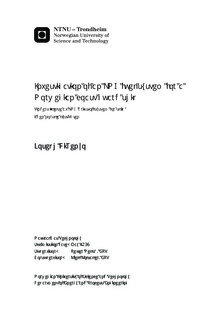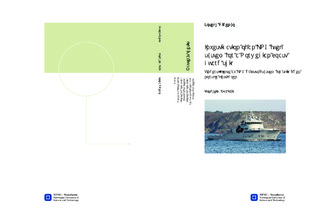| dc.contributor.advisor | Nekså, Petter | nb_NO |
| dc.contributor.advisor | Kolsaker, Kjell | nb_NO |
| dc.contributor.author | DiRenzo, Joseph | nb_NO |
| dc.date.accessioned | 2014-12-19T11:52:10Z | |
| dc.date.available | 2014-12-19T11:52:10Z | |
| dc.date.created | 2014-08-28 | nb_NO |
| dc.date.issued | 2014 | nb_NO |
| dc.identifier | 741690 | nb_NO |
| dc.identifier | ntnudaim:11874 | nb_NO |
| dc.identifier.uri | http://hdl.handle.net/11250/235576 | |
| dc.description.abstract | This report examines the reasons behind Natural Gas (NG) engine de-loading on LNG fuelled vessels. Two instances of NG engine de-loading due to low tank pressure have been document on KV Bergen in the Norwegian Coast Guard. Results from this study revealed that NG engine de-loading was caused by the disruption of the liquid surface layer in the LNG tank initiated by tank sloshing. Research found that when the surface layer between the bulk liquid and vapor in the tank was modified by sloshing the rate of vapor condensation increased faster than the mass flow rate produced by the Pressure Build Up (PBU) circuit inside the Vaporizer. Using the difference between the mass flow rate entering the vapor region and exiting through condensation, the time which a NG engine de-loading situation occurs was predicted. These conclusions were drawn from different models and calculations which analyzed factors affecting tank pressure. One model calculated the PBU mass flow rate by balancing the change in pressure in each section of the PBU. Another model developed an idealized set of equations for the time required to pressurize the LNG tank. A mixing model was also produced which calculated the lowest fall in tank pressure possible if the liquid in the tank mixed completely with the vapor in the tank. These mixing calculations proved the criteria for NG engine de-loading can be met if there is enough interaction between the liquid and vapor in the tank. A measurement campaign was carried out to understand how the different sub-components of the LNG system (LNG tank, PBU, Evaporator, and water glycol circuit) behaved during normal operations. The goal of the measurement campaign was to find real values which may be used to predict the conditions leading to NG engine de-loading. Using a heat balance from the different streams entering and leaving the Vaporizer, the average mass flow rate through the PBU circuit was determined to be 0.16 kg/s. This vapor mass flow rate is an indication of the PBU s ability to build up the tank pressure. The time required to build up the tank pressure from 295 kPa to 495 kPa was measured to be approximately 18 minutes on MF Korsfjord the morning after bunkering.The calculated and measured results were combined to draw conclusions about the main factors leading to gas engine de-loading. By comparing the idealized and actual amount of time required to pressurize the tank, it was possible to estimate that 66.2% of the vapor mass flow from the PBU condensed while the tank was being pressurized. Using the rate of vapor condensation, it was possible to calculate that the thickness of an effective conduction layer, representative of the surface layer, is 1.71 mm in undisturbed conditions. The thickness of an undisturbed tank was used as a base case to examine how modifying the thickness of the surface layer and area of the vapor liquid interface changes the rate of vapor condensation. In situations where the vapor condensation exceeded the PBU mass flow rate, the difference was used to calculate how quickly the tank pressure fell. This report also includes items for further research which would provide additional understanding of the factors leading to NG engine de-loading. Included is a detailed description of an experimental rig which may be used to find the relationship between disturbances occurring outside the tank and sloshing happening inside. Different abatement technologies are also discussed to improve the reliability of LNG systems on LNG fueled vessels. | nb_NO |
| dc.language | eng | nb_NO |
| dc.publisher | Institutt for energi- og prosessteknikk | nb_NO |
| dc.title | Investigation of an LNG fuel system for a Norwegian coast guard ship: Undersøkelse av LNG drivstoffsystem for skip i den norske kystflåten | nb_NO |
| dc.type | Master thesis | nb_NO |
| dc.source.pagenumber | 187 | nb_NO |
| dc.contributor.department | Norges teknisk-naturvitenskapelige universitet, Fakultet for ingeniørvitenskap og teknologi, Institutt for energi- og prosessteknikk | nb_NO |

